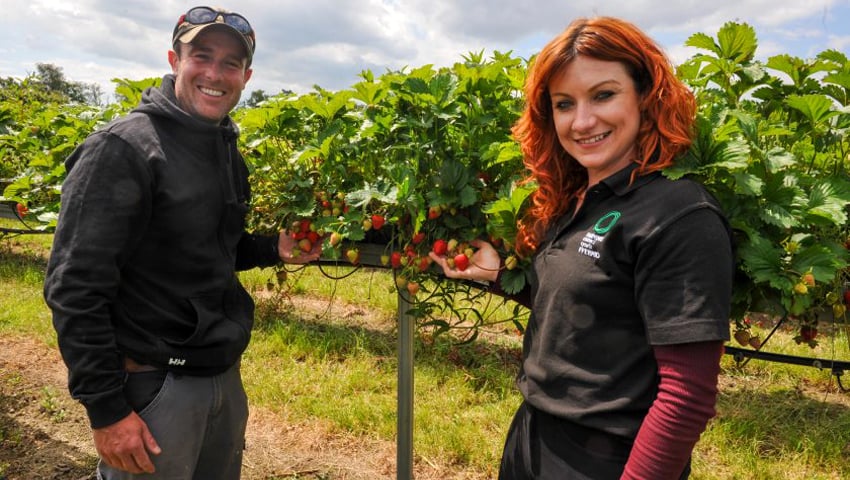A Welsh soft fruit grower who once lost his entire strawberry harvest to an insect pest is establishing colonies of a predatory bug in the crop before and during the flowering stage in a bid to find an effective biological control alternative to spraying with an insecticide.
Western flower thrips (WFT) and several other thrips species, including rose thrips, rubus thrips, onion thrips and flower thrips, are the nemesis of strawberry growers and no more so than at Bellis Brothers at Holt, near Wrexham, where thrips wiped out a crop worth £25,000 three years ago.
Even when chemical controls are applied, manager Adrian Marks says the business will lose an average of 5-10% of its outdoor-grown strawberry fruit to thrips in any given year.
Alternative and more environmentally friendly thrips controls are therefore urgently needed, particularly as WFT is widely resistant to insecticides, while resistance has also occurred in onion thrips.
There are also concerns that other thrips species that damage strawberries could also build up resistance in the future.
With funding from the Farming Connect ‘Try Out Fund’, Marks is now working with experts from the agricultural and horticultural consultancy, ADAS, to work out if a predatory bug, Orius laevigatus, could be a reliable weapon against future thrips invasions.
Jude Bennison and Andy Gladman, research entomologists at ADAS, and adviser Chris Creed, joined Marks at a recent Farming Connect event at Bellis Brothers where other growers had an opportunity to see the trial in action.
One of the obstacles to introducing Orius predators into the 60-day strawberry crops at Bellis Brothers is the plant’s short flowering period which can prevent Orius colonies establishing and building up sufficient numbers before adult thrips fly in and attack during flowering.
To help overcome this, alyssum, a potential trap plant for thrips and a ‘banker plant’ for Orius, was planted as a companion crop in the strawberry crop.
Alyssum was planted and Orius was released onto it several weeks before the strawberries flowered, aiming to provide the Orius with an early source of pollen to feed on to allow it to establish in sufficient numbers to control thrips as they fly in.
Bennison said, “The Orius for the trial were provided free of charge by Biobest UK Limited, a commercial biological control company.”
As the strawberries come into flower the hope is that the predators will move onto these and prevent fruit damage.
“Another biological control agent, a predatory mite, can be effective on strawberries but they only consume thrips larvae,” said Bennison. “The mite is effective against WFT which produces large numbers of larvae in strawberry flowers, but the other species of thrips that fly in as adults do not seem to produce many larvae on strawberry, so Orius is a better option as it will prey on the adults as well as larvae.”
If the principle behind the trial can be proven, it could be linked to a bigger project and rolled out on a bigger scale.
At Bellis Brothers, four acres of strawberries are grown on tabletops with a sequential planting system extending the fruiting period for up to eight weeks.
Because the fruit is grown outdoors for pick-your-own (PYO), it is more of a challenge to use Orius than in polytunnel or glasshouse crops as it needs warm temperatures to lay eggs and develop.
The cool, wet weather during May and early June this year wasn’t ideal for Orius.
Marks, who runs the business with his wife, Lizzie, and her parents, Roger and Joan Bellis, says his goal is to manage pests and diseases without relying on chemicals and the negative implications of these for the environment and beneficial organisms.
He said, “We hope that these entomologists can work their magic so that we have proven biological controls that can be effective on outdoor-grown strawberries. It is why we applied to take part in this trial.’’
Creed also recommends encouraging wild predators, which can be more tolerant to pesticides within integrated pest management (IPM) programmes than commercially available predators.
This could mean introducing or allowing the growth of other companion plants such as nettles in the hedgerows which provide habitat and food for predators.
Regular crop inspections should be carried out throughout the growing season, he advised.
Creed said, “Either monitor the crops yourself or use an agronomist. There should be a lot of crop walking and checking and making key decisions.”
